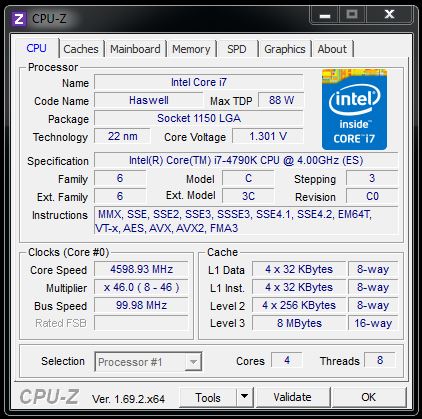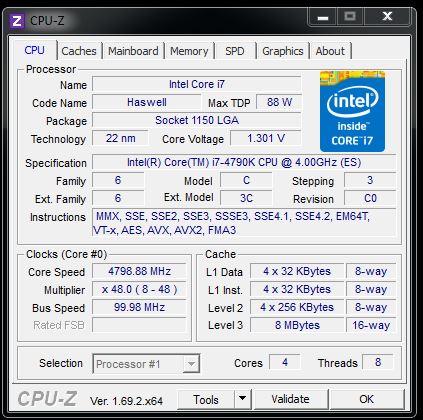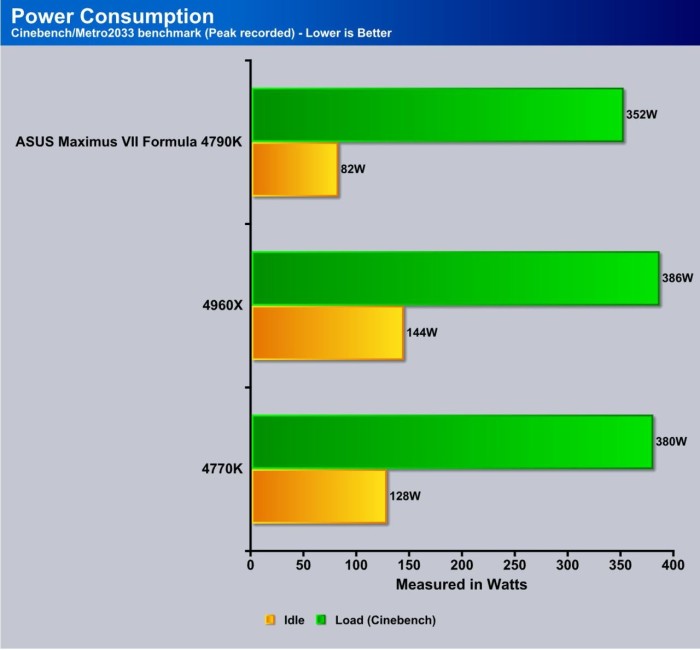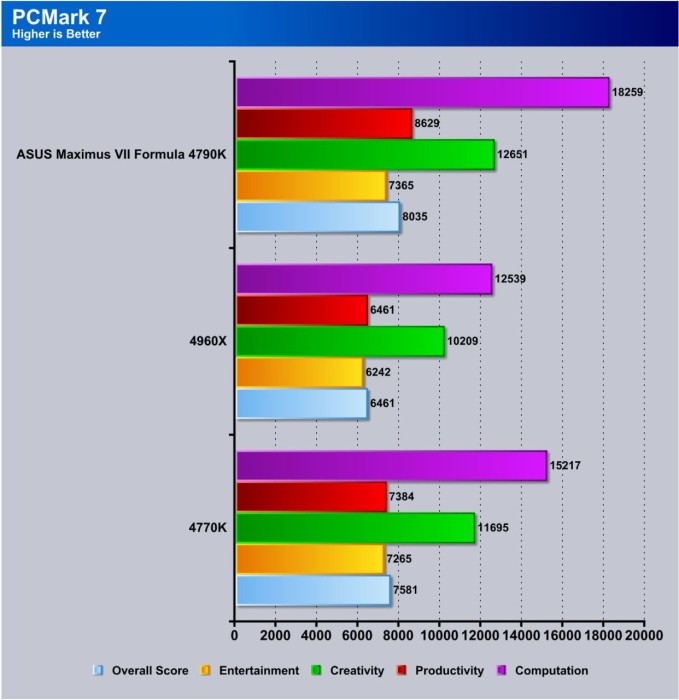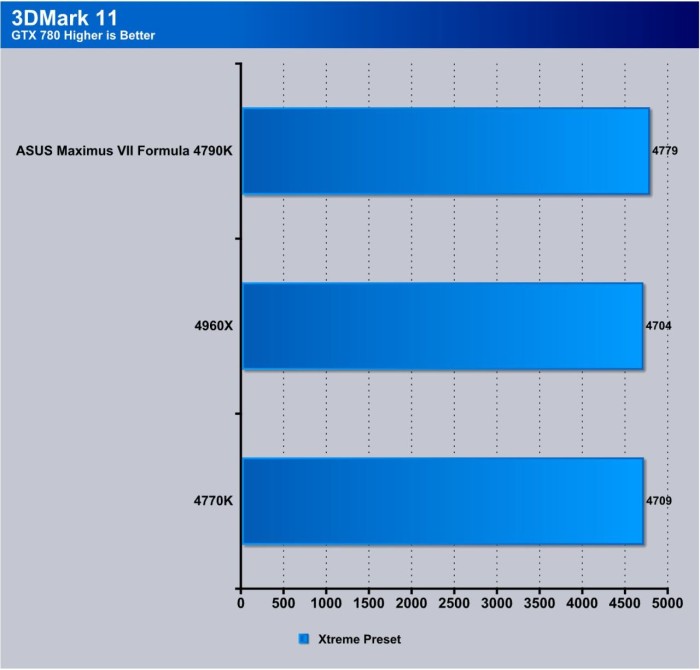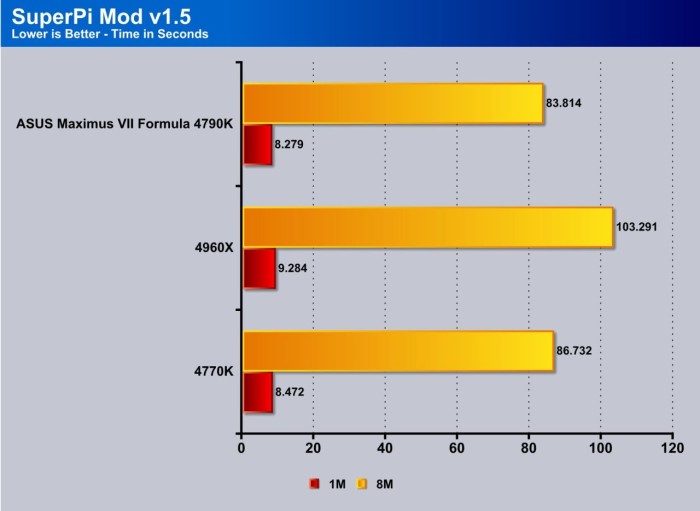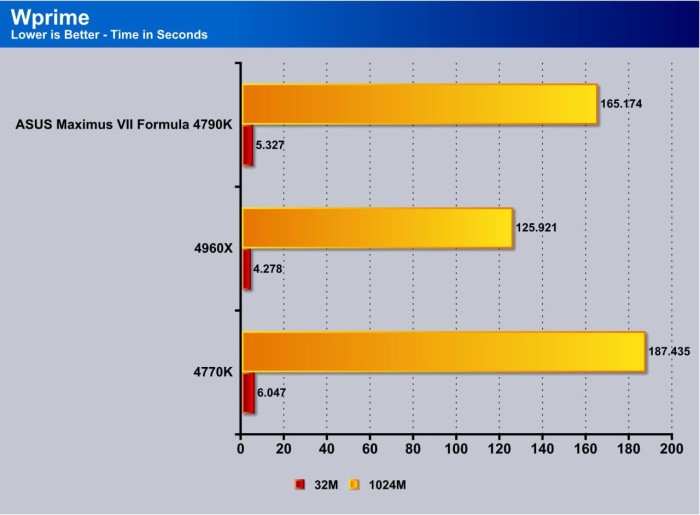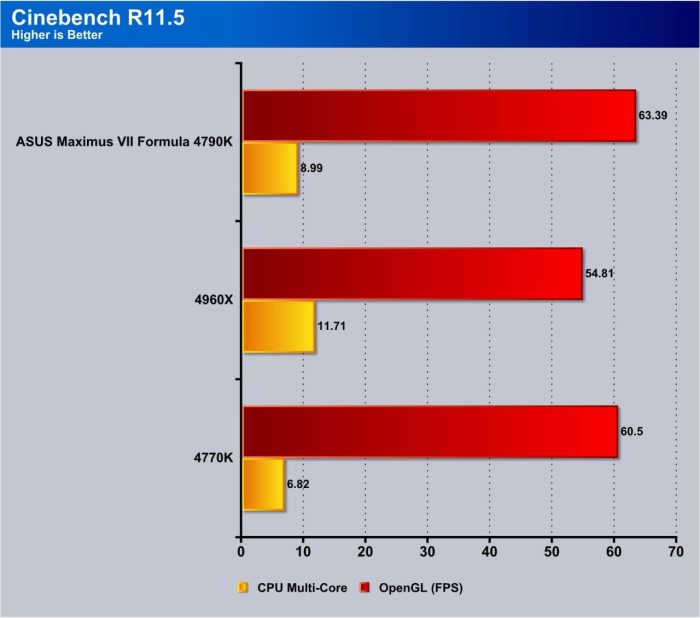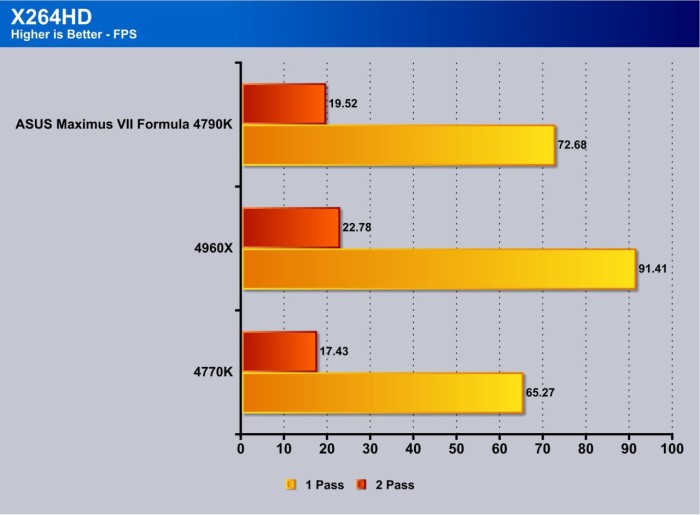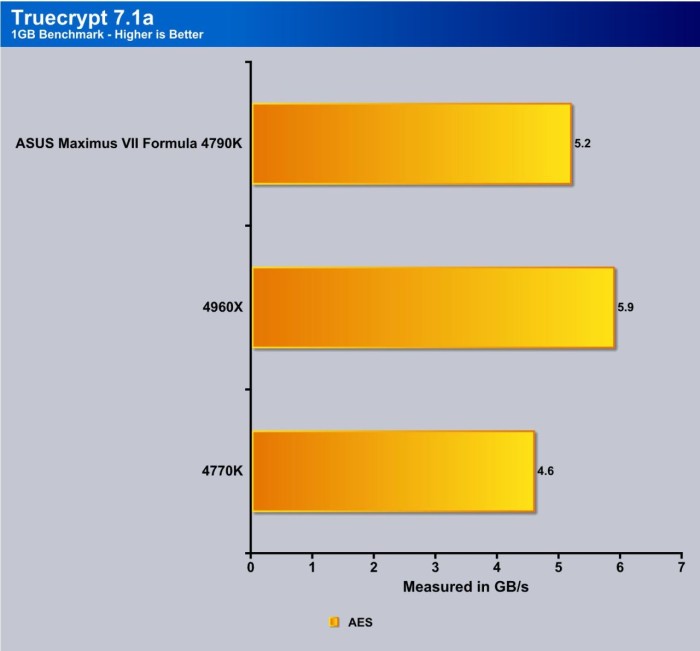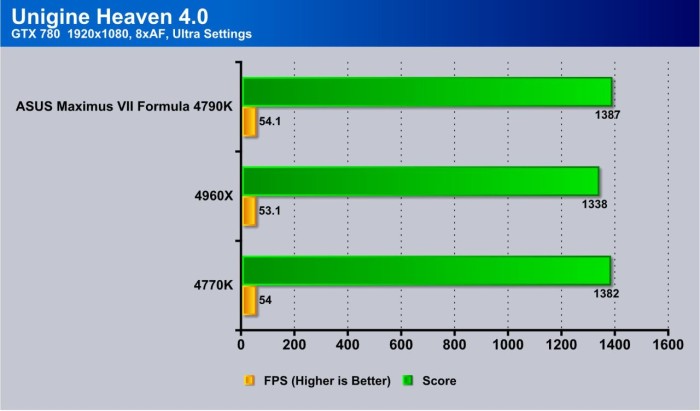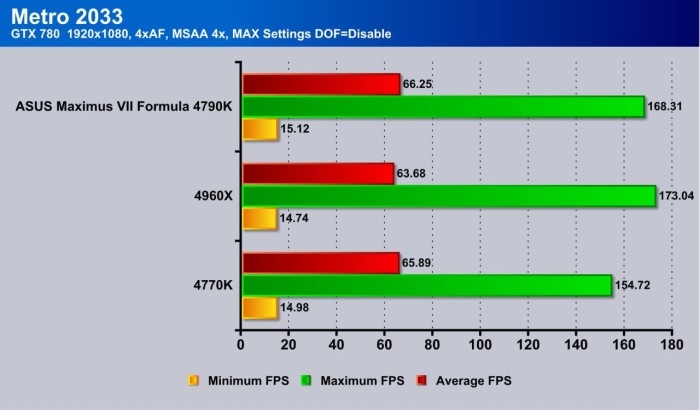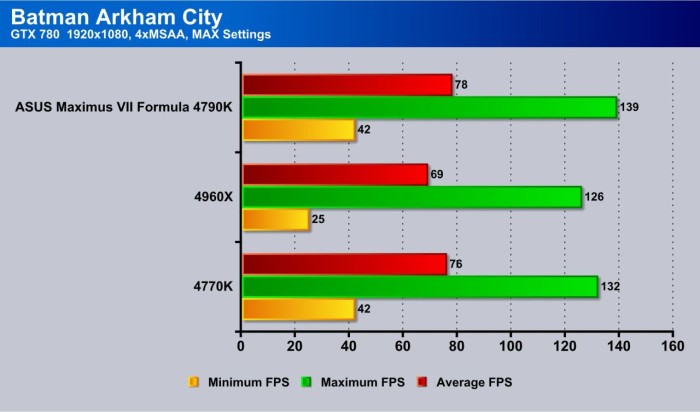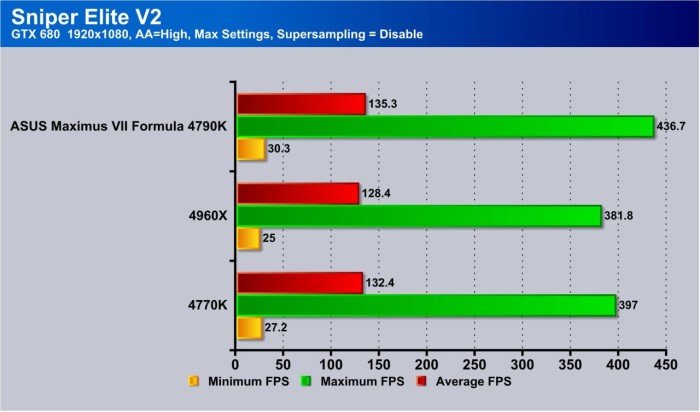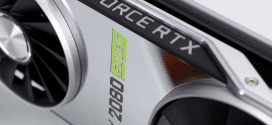Testing & Methodology

We’ve expanded our testing suite considerably since the X79 chipset release, and will continue to use the same methods for most of the motherboards and CPU’s we test. In the interests of thoroughness and accurate results, we run each test at least three times, and some tests more than that. We average the total of all the tests from each benchmark then report the average here.
The OS we use is Windows 7 Pro 64bit with all patches and updates applied. We also use the latest drivers available for the motherboard and any devices attached to the computer. We do not disable background tasks or tweak the OS or system in any way. We turn off drive indexing and daily defragging. We also turn off Prefetch and Superfetch. This is not an attempt to produce bigger benchmark numbers. Drive indexing and defragging can interfere with testing and produce confusing numbers. If a test were to be run while a drive was being indexed or defragged, and then the same test was later run when these processes were off, the two results would be contradictory and erroneous. As we cannot control when defragging and indexing occur precisely enough to guarantee that they won’t interfere with testing, we opt to disable the features entirely.
Prefetch tries to predict what users will load the next time they boot the machine by caching the relevant files and storing them for later use. We want to learn how the program runs without any of the files being cached, and we disable it so that each test run we do not have to clear pre-fetch to get accurate numbers. Lastly we disable Superfetch. Superfetch loads often-used programs into the memory. It is one of the reasons that Windows occupies so much memory. Vista fills the memory in an attempt to predict what users will load. Having one test run with files cached, and another test run with the files un-cached would result in inaccurate numbers. Again, since we can’t control its timings so precisely, it we turn it off. Because these four features can potentially interfere with benchmarking, and and are out of our control, we disable them. We do not disable anything else.
One thing to note is that we are revamping our testing method in order to better represent motherboard performance and offering to you guys the consumer. Also we want to make it an easier read for you without miles of endless charts. Please feel free to provide feedback on what you think as many benchmarks will be shuffled or removed completely.
Test Rig
| Test Rig | |
| Case | Thermaltake Level 10 GT |
| CPU | Intel Core i7-4790K |
| Motherboard | ASUS Maximus VII Formula |
| Ram | Gskill TridentX 2666MHz |
| CPU Cooler | Swiftech H20-220 Edge |
| Hard Drive | Western DIGItal Velociraptor 300GB |
| SSD | Intel 510 series SATA III 120GB |
| Optical | ASUS BD-ROM |
| GPU | ASUS GTX680 Top |
| Additional Cards | N/A |
| PSU | Thermaltake Toughpower XT 1275W Platinum |
| Mouse | Tt eSPORTS Black gaming mouse |
| Keyboard | Tt eSPORTS Meka G1 mechanical gaming keyboard |
Test Suite
We will use the following applications to test the performance of the Motherboard
| Benchmarks |
|---|
| SuperPi Mod 1.5 |
| Wprime 1.55 |
| PCMark 7 |
| 3DMark 11 |
| Cinebench R11.5 |
| X264HD |
| Truecrypt 7.1 |
| Unigine Heaven 4.0 |
| Metro 2033 |
| Batman Arkham City |
| Sniper Elite V2 |
Overclocking

The New Devils canyon as I described in the previous articles feels very much to me like Sandy Brisdge again as the chips simply hard wall at a specific speed. First off I setup the system and ran just the presets to see hwo ASUS would run without users having to select any settings and to my surprise you set 4.6G and as you see below it just goes, and its 100% Stable. The 1.3V was about what I woudl expect from previous board testing but I wanted to push further.
Setting the next preset and the max preset for the speeds was 4.8G and to my surprise not only was it rock stable but at a lower voltage than previous boards tested, now this may have alot to do with ASUS and their BIOS engineer team as I have seen results like this before but I will wait a few BIOS revisions down the road before I make a definitive judgement on this fact. One thing to note is that the fact that the ASUS board did 4.8 at 1.3V means that 4.6 shoudl be abel to be lowered a tick or two or maybe much more and we will revisit that at another time as more BIOS revisions come out and the other boards have a fighting chance.
Here you can see 4.8GHz set and operating very well. I did hope that ASUS pulled some magic out of their hat to make my chip a tick or two faster but unfortunately anything above 4.8 simply hard walls on me so this chip is at its limit at least for above ambient cooling.
Power Consumption

The power consumption was tested while running Wprime 1024 for a few minutes at stock settings. The results were recorded carefully with a Kill-A-Watt power consumption measuring tool at the wall. After the results were recorded, we waited for yet another few minutes minutes before taking Idle power consumption measurements.
The power consumption is measured without a GPU installed but the iGPU loaded to see what the best representation of peak power consumption you can expect. The Formula does well as Devils Canyon is very efficient but being there are so many features on the board you can only naturally expect it to pull a bit more power than a lower featured board.
Performance Benchmarks
PCmark 7

Here with PCMark 7 its what we have seen already which is the efficiency improvement combined with the hgher clockspeed simply takes the computation and productivity to a new level.
3DMark 11

Here you can see the 3DMark11 score does not differ alot as there simply is not a bottleneck in present gen platforms.
SuperPi
Superpi simply unleashes the beast being a single threaded app it turbos up well over 4.0GHz and simply destroying the competition.
Wprime
WPrime is similar to Superpi, but is multi core aware and you can set the core count. We used 8 cores to take advantage of the 4770K and 4790K’s HyperThreading ability (12 for 4690X). Here the Formula shows taht when coupled with the devils canyon at the higher clockrate it simply puts a hurt on the 4770K based rig but the higher thread count of the X79 takes the cake here as the operation is multi thread aware.
Cinebench R11.5
“CINEBENCH is a real-world test suite that assesses your computer’s performance capabilities. MAXON CINEBENCH is based on MAXON’s award-winning animation software, CINEMA 4D, which is used extensively by studios and production houses worldwide for 3D content creation. MAXON software has been used in blockbuster movies such as Spider-Man, Star Wars, The Chronicles of Narnia and many more. MAXON CINEBENCH runs several tests on your computer to measure the performance of the main processor and the graphics card under real world circumstances. The benchmark application makes use of up to 16 CPUs or CPU cores and is available for Windows (32-bit and 64-Bit) and Macintosh (PPC and Intel-based). The resulting values among different operating systems are 100% comparable and therefore very useful with regard to purchasing decision-making. It can also be used as a marketing tool for hardware vendors or simply to compare hardware among colleagues or friends.”
X264HD

Transcoding has become more popular now and the latest Sandy Bridge processor added support for AVX instruction for faster video transcoding. The higher clock rate and efficiency gains once again pays dividends here with excellent results over the 4770k.
Truecrypt 7.1

TrueCrypt is a real world application that gives a good indication of the true performance of our latest processor. Here once again the higher speed 4790K puts a hurt on the 4770K
Unigine Heaven 4.0

Unigine Heaven is a benchmark program based on Unigine Corp’s latest engine, Unigine. The engine features DirectX 11, Hardware tessellation, DirectCompute, and Shader Model 5.0. All of these new technologies combined with the ability to run each card through the same exact test means this benchmark should be in our arsenal for a long time.
Unigine Heaven on a discrete GTX 780 gains about a single FPS, probably just due to the expanded performance with the overclock. For the most part, however, recent platforms are so efficient that there simply is no bottleneck for current gen card models.
Metro 2033

Once again, Metro 2033 shows that discrete GPU performance is relatively unaffected, simply due to the fact that there is already so much unused bandwidth available.
Batman Arkham City
Discrete GPU results once again hover without huge movement as the bandwidth is unsaturated for PCIe 3.0.
Sniper Elite V2
The overall trend here is the same as for the other discrete GPU results, the formula here shows a slight increase over most models we have tested but the difference is marginal so i must assume that the GPU simply is seeing most of the load here.
Our Final Thoughts
 The ROG team is always working on new ways to make noise in the market and the Maximus VII Formula is no exception. While there are some Z97 centric feature upgrades alot of it cannot help but feel like its coming from the Z87 variant as its more like an upgraded version. This however is not a bad thing as the Maximus VI Formula was a great board and the Maximus VII Formula has proven to be just as good with some new toys onboard.
The ROG team is always working on new ways to make noise in the market and the Maximus VII Formula is no exception. While there are some Z97 centric feature upgrades alot of it cannot help but feel like its coming from the Z87 variant as its more like an upgraded version. This however is not a bad thing as the Maximus VI Formula was a great board and the Maximus VII Formula has proven to be just as good with some new toys onboard.
Z97 as a whole is suffering from the push to SATA Express since from what we have seen availability of SATA Express parts is scarce to non existent which means you now have a port that cannot be utilized which is why I am glad they can be used as standard SATA ports. While there are no SATA Express parts now we all know there will be some but looking at the current ecosystem of storage I am concerned that the parts wont arrive until after the obsolescence of this platform or at least close to EOL which means if the only reason to buy Z97 is the SATA Express you may want to hold off.
However if you want a super capable gaming platform that can overclock well but games so well it doesnt need to be and its time to upgrade or build the Maximus VII Formula is an absolutely phenomenal choice for a gaming platform as it has tons of features, all kinds of compatibility and even a free Watch Dogs game pending you get the Watch Dogs version!
| The Pro’s: | Cons |
|
|
Review Overview
Performance
Value
Quality
Features
Innovation
The ASUS Maximus VII Formula has all the right features and great looks which make it a must have and well deserving of the Bjorn3D Golden Bear Award.
 Bjorn3D.com Bjorn3d.com – Satisfying Your Daily Tech Cravings Since 1996
Bjorn3D.com Bjorn3d.com – Satisfying Your Daily Tech Cravings Since 1996

